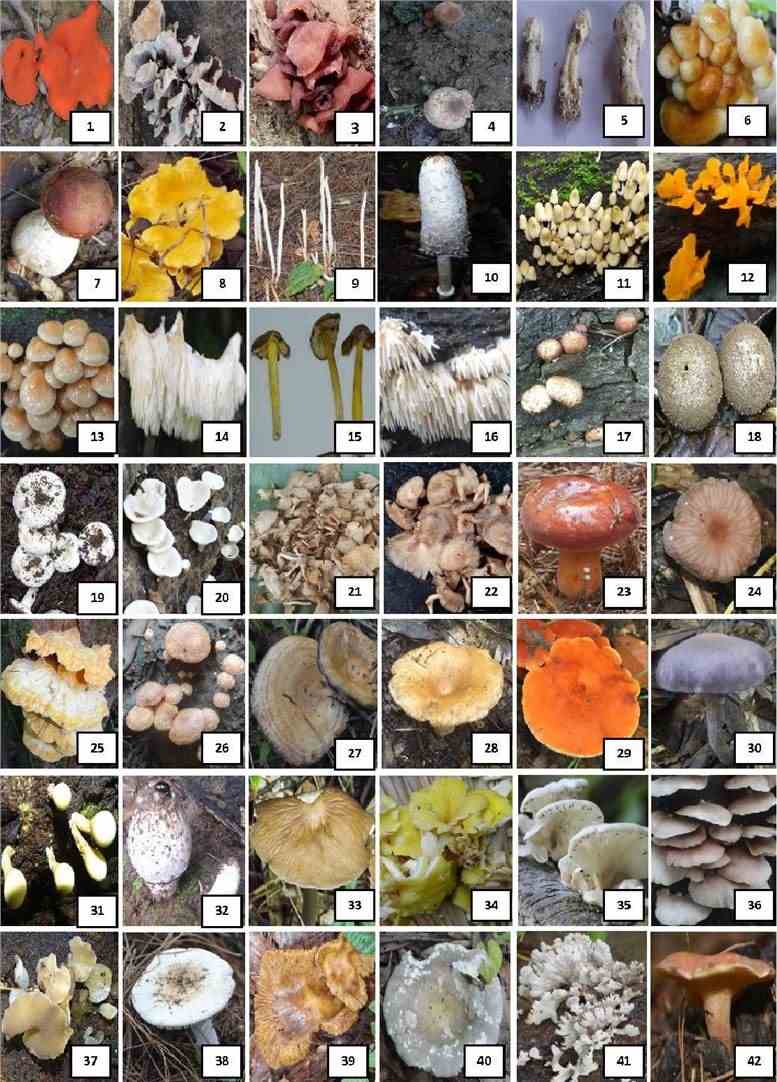In the kingdom of fungi, the phyla Ascomycota and Basidiomycota are the main phyla with fruiting bodies and are considered mushroom. Ascomycota is the largest fungal phylum, with over 64,000 species. There are more than 40,000 species in Basidiomycota, which includes important groups such as mushrooms, plant pathogenic black spikes, rusts, and important industrial yeasts. Identifying mushroom fungal groups to the species level are paramount in the basis and application of scientific research. However, mushroom identification can be a challenge. Many species look, smell, and even taste similar. In addition, the appearance of a particular species often changes over time as individual mushrooms age. Taxonomic identification of mushroom fungi is essential if industrial, agrochemical, or pharmaceutical products are to be extracted from mushroom fungal strains.
 Fig. 1. Wild edible mushrooms of Nagaland. (Lücking R, et al., 2020)
Fig. 1. Wild edible mushrooms of Nagaland. (Lücking R, et al., 2020)
Services
Accurate mushroom identification can provide insights for developing better screening procedures to discover interesting natural products and additional information on the ecology, phylogenetic relationships, genomics, and transcriptomics of mushrooms. We aim to help clients identify, classify and detect different species of mushrooms and recommend edible mushroom species for cultivation. Lifeasible offers customized identification services for mushroom fungal groups.
Identification of Mushroom Fungal Groups Based on Morphology
Our experts identify different mushroom species by observing the overall morphology of the mushroom based on the following morphological characteristics.
- Gilled mushrooms
- Mushrooms with porous surfaces
- Mushrooms with small pores and a woody texture
- Toothed fungi
- Jelly fungi
- Coral fungi
- Puffball mushrooms
- Mushrooms that appear wrinkled or honeycombed
- Truffles
- Earth tongues
- Bird's nest fungi
- Cup-shaped fungi
Identifying fungi based on morphology alone is challenging, and the number of morphological characters available for identification is limited. Especially for mushrooms in culture, ascospores are not usually produced in culture, making it difficult to identify them based on morphology alone. Lifeasible offers DNA sequence-based methods to identify species in large numbers of mushrooms. Our strategies include, but are not limited to:
- Molecular identification of fungi
- Fungal DNA barcoding
- BLAST search
- Selected fungal barcode databases
- Secondary barcode markers in fungi
- Multiple sequence alignment and tree construction techniques
We combine micromorphology, culture, molecular characterization and molecular data to identify species in many mushrooms. Our experts have the patience and dedication to help you accurately identify wild mushrooms, opening up the world of mushrooms for culinary, medicinal, and ecological review, and enjoyment. Please do not hesitate to contact us. We look forward to a wonderful collaboration with you!
Reference
- Ao T, Deb C R. (2019) Wild Mushrooms of Nagaland, India–An Important Bioresource[J]. Studies in Fungi. 4(1): 61-78.
For research or industrial raw materials, not for personal medical use!


 Fig. 1. Wild edible mushrooms of Nagaland. (Lücking R, et al., 2020)
Fig. 1. Wild edible mushrooms of Nagaland. (Lücking R, et al., 2020) 